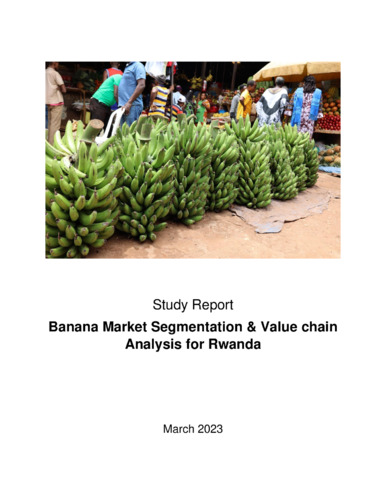Banana market segmentation & value chain analysis for Rwanda: study report
Abstract
A study was conducted in Rwanda to identify and characterize different banana market segments, with a focus on cooking and dessert bananas. The goal was to generate production and market-related information to inform the development of banana target product profiles (TPPs) for Rwanda, which can support crop development programs and other actors in meeting the needs of different end-users such as farmers, processors, and consumers. The study employed a mixed-methods approach consisting of qualitative and quantitative data collection methods, including a stakeholders' workshop, an experts' workshop, and semi-structured interviews with various actors along the banana value chains.
The findings indicate that Banana’s importance as a food and cash crop continues to grow with time in Rwanda. With a fast-growing population, urbanization, and the influx of people from high banana eating countries in the recent past, consumption of cooking banana has widened both in quantity and variety of cooking ways (dishes). This presents both challenges and opportunities for value chain actors to meet the changing demands for new products e.g., varieties or traits. The production of cooking banana has been steadily increasing at the expense of beer banana, with both now occupying almost equal shares of planted areas. Meanwhile, the proportion of dessert banana has also seen growth over time. Nevertheless, the importance of beer banana remains strong due to better adaptability of beer cultivars in some locations, easy marketing in poorly connected regions, and its importance to the beer and wine industry in the country.
Male and female farmers in Rwanda have similar preferences for cooking and dessert banana traits. However, brewing banana seems to be a male’s crop, most likely because it is mainly grown for cash rather than food for home consumption. Banana farmers tend to sell their surplus produce to multiple market options, preferring nearer markets to reduce transportation costs, which is one of the key challenges to marketing. Urban consumers' preferences for cooking and dessert banana are narrow in range and common across different groups. However, their choice of variety in the market is highly associated with prices, resulting in affluent and less affluent consumers eventually eating different varieties for both cooking and dessert banana. This leads to market segments being strongly determined by purchasing power and geographical differences.
The study revealed that crop improvement has great potential to improve farmers' livelihoods by addressing production constraints and responding to changing consumer preferences. Diseases such as Banana Xanthomonas Wilt (BXW), Fusarium Wilt, and Banana Bunchy Top Virus remain significant challenges to production. Many landrace cultivars with preferred traits are low yielding and susceptible to these diseases. Moreover, there are insufficient crop development capacities at RAB, which has resulted in no release of improved varieties for cooking banana for a long time. With little effort, Rwanda can benefit from breeding achievements that have been made in the region recently. However, this requires better regional collaboration, as well as financial and technical support for crop development work in Rwanda. This includes development of a strategy (including methodological framework) on how to prioritize, design, and involve different value chain actors in the introduction, testing, and evaluation of new germplasms.

